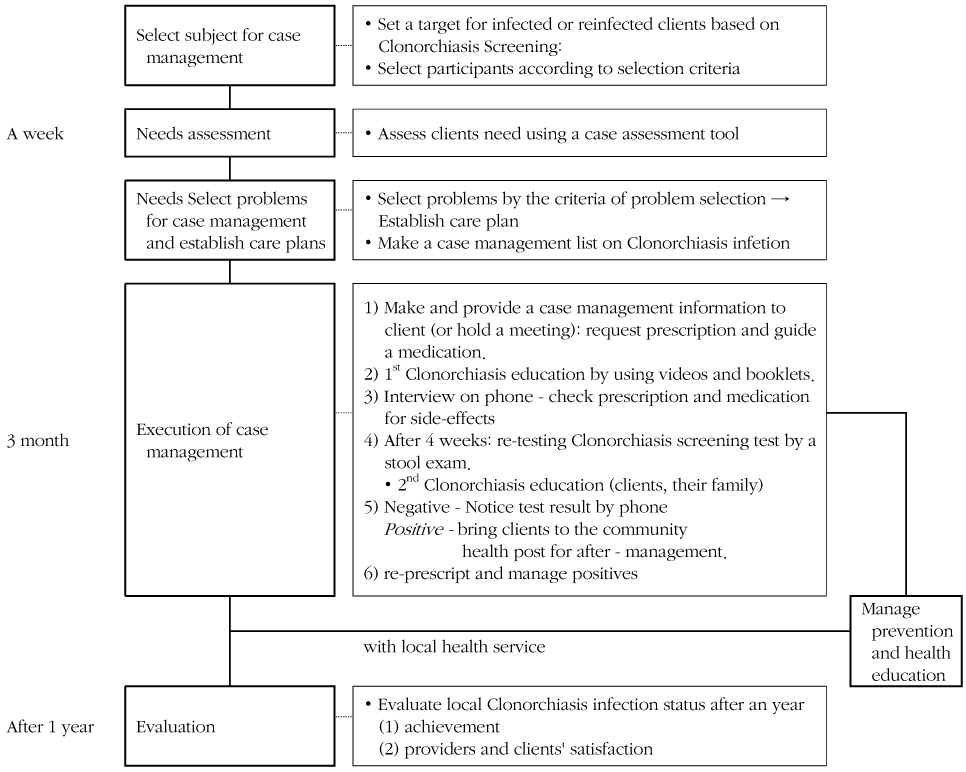J Korean Acad Community Health Nurs.
2012 Dec;23(4):427-437. 10.12799/jkachn.2012.23.4.427.
The Effects of Case Management for Clients with Clonorchiasis in Riverside Areas
- Affiliations
-
- 1Department of Nursing, Sunmoon University, Asan, Korea.
- 2College of Nursing, Gachon University, Sungnam, Korea. hgkim@gachon.ac.kr
- 3Department of Nursing, Soonchunhyang University, Cheonan, Korea.
- 4College of Nursing, Eulji University, Daejeon, Korea.
- KMID: 2292786
- DOI: http://doi.org/10.12799/jkachn.2012.23.4.427
Abstract
- PURPOSE
In order to lower the infection rate and the reinfection rate of Clonorchiasis in high-risk areas, we performed and analyzed a case management on people with chlonorchisis.
METHODS
The data was collected from April 2010 to March 2011. A community health practitioner was selected as a case manager based on our training program. The intervention group had 58 participants with three months of case management and the control group had 144 participants handled with traditional methods.
RESULTS
The pre and post-test in the intervention group and the control group showed us improved knowledge of Clonorchiasis, attitudes and behavior toward eating freshwater fish. The results of post-test between the intervention group and the control group showed statistically significant differences in all categories, except a hand-washing category. However, one year after a case management, there was no significant difference in the failure rate of treatment.
CONCLUSION
The case management was effective for people infected with Clornorchiasis near riverside areas; however, in order to lower the rates of reinfection and treatment failure, it is necessary to perform continuous monitoring and regular evaluations.
Keyword
Figure
Cited by 1 articles
-
Population-Based Regional Cancer Incidence in Korea: Comparison between Urban and Rural Areas
Haa-Na Song, Se-Il Go, Won Sup Lee, Yire Kim, Hye Jung Choi, Un Seok Lee, Myoung Hee Kang, Gyeong-Won Lee, Hoon-Gu Kim, Jung Hun Kang, Yune Sik Kang, Jeong-Hee Lee, Jin-Myung Jung, Soon Chan Hong
Cancer Res Treat. 2016;48(2):789-797. doi: 10.4143/crt.2015.062.
Reference
-
1. Cesta TG, Tahan HA, Fink LF. The case manager's survival guide: Winning strategies for clinical practice. 1998. St. Louis, MO: Mosby.
Article2. June KJ, Lee JY, Yoon JL. Effects of case management using resident assessment instrument-home care (RAI-HC) in home health services for older people. J Korean Acad Nurs. 2009. 39(3):366–375.3. June KJ, So AY, Kim CM, Kim SY, Song YL, Jung HY, et al. Survey and control program development of clonorchiasis for high risk population at 5 major river in Korea. 2009. Seoul: Korea Centers for Disease Control and Prevention.4. Kim CM. Development of monitoring system and prevention of high risk population for clonorchiasis extermination of korean main riverside area. 2011. Seoul: Korea Centers for Disease Control and Prevention.5. Kim CM, So AY, June KJ, Jung HY. A study on the prevalence of clonorchis sinensis and the effects of educational program among residents in the basin of the youngsan river, Korea. J Korean Acad Community Health Nurs. 2011. 22(1):56–65.6. Kim HG. Development of case management model for the bed-ridden elderly at home and its evaluation: Focusing on RAI MDS-HC 2.0 Application. 2002. Seoul: Chung-Ang University;Unpublished doctoral dissertation.7. Kim HG, Kang HK, So AY, Kim YS, Park JI, Tak KS, et al. A study on the prevalence and related factors of Clornorchis Sinensis for high risk population at Hangang riverside area. J Korean Acad Rural Health Nurs. 2009. 4(1):13–21.8. Kim HG, Jung KJ, Kim SY, Park MS, Kim CM. Clonorchis sinensis infection experience in residents living in riverside areas. J Korean Acad Community Health Nurs. 2010. 21(1):110–117.9. King R, Meadows G, Le Bas J. Compiling a caseload index for mental case management. Aust N Z J Psychiatry. 2004. 38(6):455–462.10. Korea Centers for Disease Control and Prevention. Prevalence of intestinal parasitic infection in Korea-the 7th report. 2005. Seoul: Author.11. Park JY, June KJ, Park DS, Jho KN, Jho JS, Kim SC, et al. Prevalence of clonorchiasis, knowledge and intention to change behavior of village people living in the catchment area of community health posts along the Geum River. J Korean Acad Rural Health Nurs. 2009. 4(1):5–12.12. Shin SA. Evaluating a community-based case management program for people with diabetes in Korea. 2009. Bandoora, Australia: La Trobe University;Unpublished doctoral dissertation.13. Song IW. An epidemiological study on clonorchial infection of the inhabitants living in some regions adjacent to Daecheongho. 2007. Daejeon: Chungnam National University;Unpublished master's thesis.14. Song YY, Park KS, Kwon YS, Kim NH, So YS, Lee MS. Knowledge and prevalence status of clonorchiasis for inhabitants in the nakdong riverside area. J Korean Acad Rural Health Nurs. 2009. 4(2):87–93.
Article15. Yang SO, Kwon MS, Choi YJ, Lee SH. The effects of a case management program of customized home visiting health service for clients with arthritis. J Korean Acad Community Health Nurs. 2011. 22(2):151–161.
Article
- Full Text Links
- Actions
-
Cited
- CITED
-
- Close
- Share
- Similar articles
-
- Clonorchis Sinensis Infection Experience in Residents Living in Riverside Areas
- Prevalence and Related Factors of Clonorchiasis among Five Major Riverside Residents in South Korea
- Prevalence of Clonorchis sinensis Infection among Residents along 5 Major Rivers in the Republic of Korea
- Effects of a Clonorchiasis Prevention Education Program for Clonorchiasis Prevention Lecturers
- Prevalence and Risk Factors of Clonorchiasis among the Populations Served by Primary Healthcare Posts along Five Major Rivers in South Korea


